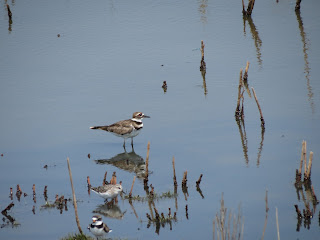An Eagle Encounter – The Highlights
Bags packed
into the back of my Jeep, I set off on Friday to pick up two fellow members of
my birding group and drive to the Delaware Water Gap for the weekend. Our goal:
view elusive warblers. We drove north
through lush green farmland, which gradually rose to hills as we neared the
Pocono Mountains.
Saturday
morning we ate breakfast in our hosts’ house in PA before meeting up with two
members at the first I- 80 rest area on the New Jersey side of the Delaware
River. Then the eight of us headed up Old Mine Road, which snakes up along the
Delaware. It was like driving on an obstacle course as I avoided numerous potholes
on this very narrow road.
Wild flowers
dotted the fields and edges of the road, which was over hung by enormous trees,
now in full leaf. Since it rained Friday night, water gushed down the many
brooks to our right as they made their way to the river. As the driver, I
caught only glimpses of them as we drove past. But at one of our stops, we were
able to explore one while looking for a Louisiana Waterthrush. After much
searching, only a few of us saw that bird. Perhaps if the roaring and splashing
waterfalls hadn’t drowned out the bird’s calls, it would have been easier to
find.

One of the
highlights for me was seeing a Red-Eyed Vireo peeking out of a nest. While at
Worthington Office and Campground, we saw a Bald Eagle soaring overhead, The
most exciting bird experience that day was our close encounter with another
Bald Eagle. I was driving slowly as we watched for our next stopping place when a very large
bird swooped down out of the low hanging trees, right at the windshield. For a
split second, I thought it was a Turkey Vulture looking for carrion along the
road, but immediately realized it was a Bald Eagle. For one frightening moment,
he was coming straight at us. I came to a full stop at the same time he veered
to the side and landed next to a dead squirrel, not something Bald Eagles
usually go after.
He flew
up and landed on a wire crossing the road. I parked off to the side. Everyone
got out and ran back to get a good look and take pictures. But a car full of
teenagers had the same idea, and three motorcyclists roared past. With all the
commotion, who could blame the eagle for flying away, which of course he did. I
had no chance to get his picture, but others in the group managed to take some.
We had a
picnic lunch at a restored village, stopped at Peters Valley and browsed in the
crafts store, and returned to our hosts’ house in PA by way of the Dingmans Ferry
Bridge.
Sunday some
of us set out again. But the birds stayed better hidden. After a short time on
Old Mine Road, we drove up to High Point where we saw a Raven, Towhee, and
Great Crested Flycatcher. Since we had the long drive ahead of us and rain was
imminent, we then headed home.
High Point Monument
Following is
a partial list of other birds sighted: Northern Rough-winged Swallow,
White-breasted Nuthatch, American Redstart, Veery, Chimney Swift, Hooded
Warbler, Northern Parula, Chestnut-sided Warbler, Yellow-throated Warbler, and
a Phoebe. The birds I haven’t listed are, for the most part, more common. The ones
on this list are new to me. An advantage of being a newbie is that I’m always
adding birds to my life list – with the help of the seasoned birders. One of my
passengers is the group’s president. She’s not only expert at identifying
birds, but she also is a professional nature photographer. While I’m trying to
focus on a bird, she’s already snapped its picture.
We’re
already planning our next over-night trip. By then, I’m hoping to be more
accomplished at photographing birds. It’ll help if I can learn how to use my
camera better.
















